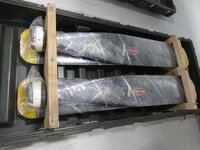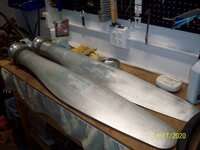rrmerlin60
Airman
- 22
- Dec 18, 2009
Hi,
I've been wondering, how are typical WW II propeller blades made. For example, the 24D50 paddle blades from the P-51D, has a large "bulb" on the root end, and some rings, spacers, and other hardware that cannot be removed once the blade is created. How did these parts go onto the blade in the manufacturing process ? What happens during restoration, if the blade is generally good, but these parts are damaged and need replacing ?
These aren't the best pics, but you can see there are ring shaped items that wouldn't fit over the bulbed root end of the blade. So how are these blades made ? I know the bearings are half-circles, so no mystery there. But some of these parts are continuous circles.
Thanks, Tom.
I've been wondering, how are typical WW II propeller blades made. For example, the 24D50 paddle blades from the P-51D, has a large "bulb" on the root end, and some rings, spacers, and other hardware that cannot be removed once the blade is created. How did these parts go onto the blade in the manufacturing process ? What happens during restoration, if the blade is generally good, but these parts are damaged and need replacing ?
These aren't the best pics, but you can see there are ring shaped items that wouldn't fit over the bulbed root end of the blade. So how are these blades made ? I know the bearings are half-circles, so no mystery there. But some of these parts are continuous circles.
Thanks, Tom.


